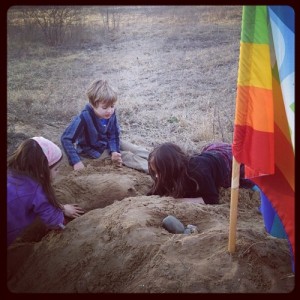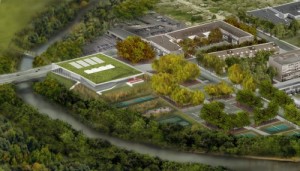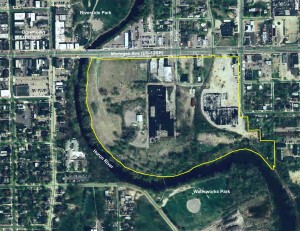Image may be NSFW.
Clik here to view. Over the course of the past week or so, I’ve posted twice about the 38-acre vacant lot at the heart of downtown Ypsilanti commonly referred to as Water Street. In the first post, which was written in response to news that Family Dollar had expressed interest in building on the site, I outlined my objection to the bargain chain being the anchor around which this development project, which very well could define our City for next several decades, takes shape. And, in the second, I held up Grand Rapids, where they’re investing in infrastructure to serve their local food entrepreneurs, and not just pinning their hopes on an out-of-state bargain chain that pays minimum wage, as an example of economic development done right. Well, the resulting conversations were very interesting, as you might imagine. This was especially true of the comments which explored the possibility that Water Street could be a suitable home for a year-round farmers market, like the one presently being constructed in Grand Rapids (only perhaps somewhat scaled down). And, tonight, I’ve decided to move a few of these comments (slightly edited) up to the front page, in hopes that they might spur additional conversation on the subject.
Over the course of the past week or so, I’ve posted twice about the 38-acre vacant lot at the heart of downtown Ypsilanti commonly referred to as Water Street. In the first post, which was written in response to news that Family Dollar had expressed interest in building on the site, I outlined my objection to the bargain chain being the anchor around which this development project, which very well could define our City for next several decades, takes shape. And, in the second, I held up Grand Rapids, where they’re investing in infrastructure to serve their local food entrepreneurs, and not just pinning their hopes on an out-of-state bargain chain that pays minimum wage, as an example of economic development done right. Well, the resulting conversations were very interesting, as you might imagine. This was especially true of the comments which explored the possibility that Water Street could be a suitable home for a year-round farmers market, like the one presently being constructed in Grand Rapids (only perhaps somewhat scaled down). And, tonight, I’ve decided to move a few of these comments (slightly edited) up to the front page, in hopes that they might spur additional conversation on the subject.
The first comment comes from Jean Henry, the former owner of Ann Arbor’s Jefferson Market, who, at present, leads environmental sustainability initiatives at Zingerman’s.
On a very basic level I love (the idea of a year-round, food-centric facility on Water Street). My understanding, right now, is that we are maxed out on farmer’s markets, though. There simply aren’t enough farmers to supply any more markets. They are spread too thin. Farmers can’t farm and simultaneously be at 5 markets a week. To do so would mean that they would need to hire someone to tend the stand, and then everyone would complain about the increased price of the food being sold. That said, from what I understand, farmers like the big markets. So, if this one were to intentionally take the place of existing Ypsi markets, and maybe house a food hub, so that distribution could be done on-site as well, then it could work. I suppose a feasibility study would bring all this to light. I think, in general, proposing something grand and inspiring and forward thinking, and then asking the question “Do we need it?” in a non-anecdotal way, via a feasibility study, will bring you the solution that you seek. I’m pretty sure you don’t need a dollar store. Those giant businesses have a high-margin model where mistakes can be afforded. (i.e. They can open and close and the brand keeps on going.) Food does not. Almost anything you would want on Water Street does not. And so it will be hard to pull off. It will also be very hard to fund. But the chances of it sticking around and working for the good of Ypsi for the long haul are much greater. Even if you didn’t pull it off, the process of the City (by which I mean its citizens) visioning what it wants, determining what it needs, and trying to pull it off, would be really useful for Ypsi. At minimum you would all learn a lot. The future of Ypsi is really up to the citizens. If you all could get something bigger scale started, maybe the City, and groups like Eastern Leaders, could follow (rather than trying to lead) and assist. Then you’d really be on your way to having the City you all deserve. Water Street is a really great piece of property. Despite the troubles, it has incredible potential. As does all of downtown Ypsi.
And, a little while later, Jean added the following.
Waiting for offers (as was the case with Family Dollar) is almost always a bad idea. Maybe Ypsi just needs to try a little harder on its own behalf. I don’t mean just the government, I mean all of you. Funding IS possible. It would just require a lot of work. A public/private partnership, all stakeholders engaged, outside investors… even tax breaks in the short term for a larger tax base in the long term. There are lots of progressive redevelopment models out there, but none are easy, and local models are almost non-existent. The major stakeholders and an active citizenry need to be on board. And to get to that you need a great vision – which I think Mark has begun here. Rather than assume what is and isn’t possible (which I also did in my earlier comment, admittedly), I think it would be great if people could start to weigh in on what they CAN do. What alliances can be formed? What funding mechanisms exist? What are Ypsi’s strengths rather than its limitations? You actually have tremendous capacity in terms of an engaged (if somewhat cynical) citizenry, progressive thinkers, people that understand city planning and hybrid corporate structures, a major university, a predominantly thriving (by MI standards) county, AND a really beautiful piece of property on a riverfront downtown with an Olmsted-designed park corridor, within a mile of a major freeway and rail lines. I don’t know if you all realize what an unusual municipal asset that is. There are so many people at the universities, in county government and in economic development in the wider metro area who could help you all realize a great vision. But first you all need to stand tall and say, “We have something of value and we want to work hard collectively to make the most of it.”
A great model for sustainable development (and the hurdles one faces – the path has not been at all easy, and the formerly giant project has scaled down considerably) is the North Charleston Noisette project (in North Charleston, South Carolina). I spoke to the developer, John Knott, a few years ago about Water Street and he was interested in talking to someone in Ypsi about it. (I don’t think that ever happened.) I think the scale of it was appealing to him, relative to the behemoth that he took on. Also, I know at one point Eastern Leaders was looking at the whole corridor behind Water Street to 1-94 for economic development, so there really is a bigger potential package than just Water Street. There are people out there who know how to do this work. And they can tell you what is possible. Your sense of constriction originates, at least in part, in a tiny tax base. The city lines are simply drawn too tightly around downtown. I really believe to overcome that sense of constriction you need to look to the surrounding area for help and be prepared to believe and demonstrate that you are worthy of investment. You will also need to be very clear about what you want. Ypsi’s potential is so obvious to me. I really hope you guys take another stab at the Water Street windmill.
Image may be NSFW.
Clik here to view. And, this comment comes from Amanda Edmonds, the director of Growing Hope, the organization that, among other things, runs Ypsi’s existing Downtown Farmers Market.
And, this comment comes from Amanda Edmonds, the director of Growing Hope, the organization that, among other things, runs Ypsi’s existing Downtown Farmers Market.
A few comments on both farmers’ markets – and saturation points – and a public market on Water Street. I’ve spent considerable time thinking and working on both!
So, as for farmers’ markets, my view is that we are at a saturation point for small neighborhood or small-community markets in Washtenaw County, particularly in places where food access and transportation aren’t big barriers for people. I wouldn’t say we’re at a saturation point nation-wide – there are many communities where there’s no good access to a market, or other fresh, healthy, local food options – and I’m really pleased with where we are in Michigan overall, mostly because we are a leader in the country when it comes to markets that accept EBT/SNAP. I’m proud that our Downtown Ypsilanti Farmers’ Market (DYFM) was the third in Michigan to accept EBT (back in 2006 when we started – and props to the Ypsi Food Co-op for helping provide the capacity to make that happen), and that this year 103 markets across the state accepted EBT. Many of the markets across the state doing EBT spent the day together last Monday in Turkeysville, MI reflecting and figuring out what’s next – all thanks to the amazing leadership of MIFMA (the Michigan Farmers’ Market Association) which is a lean organization that deserves much of the credit for our markets rocking out in Michigan. The total season EBT sales for markets across the state may top $1 million this year– which is only a small percentage of overall EBT sales, but it’s growing at an amazing rate. The DYFM topped $18,000 in EBT sales alone in 2012 – and that’s just during a four hour block on Tuesday afternoons in downtown Ypsi from May through October… So, the fact that more markets are being supported in areas where food access is difficult, is amazing. And it’s great that communities are creating markets as central squares and community gathering spaces.
The challenge is in what it takes to sustain a market. It costs us a lot of money, and we fundraise for to make our market what it is. Markets are not financially self-sustaining, particularly when they, like the DYFM, offer EBT and other programs/incentives that support food access, healthy eating education, support for small business development, et al. We’re going to see – and already are, in some ways – a boom and bust in markets who don’t have the capacity – or the ability to raise the funds to build capacity – to keep afloat. A lot of market managers are volunteers, and that becomes challenging when you’re basically running a bank on the back end (via token systems), and as a result you have a lot of turnover, which makes it hard to provide consistency to the many small businesses (farms, bakers, et al) who are relying on you for their income, and to the customers who are relying on you for their food. So, one thing I think we need, and are going to start seeing, is some consolidation of markets so that we can have well-run farmers’ markets with the efficiencies that come from that. Not one mammoth market monopoly, but just thinking about how to clump some markets under single entities that can provide shared marketing, vendor coordination, etc… There are also opportunities for winter markets. We go inside the Corner Brewery in November and December, and have a long waiting list of vendors who would like to be in this smaller space. As more growers are doing season extension, and there are more cottage food vendors, etc, we need opportunities for more permanent market space and indoor opportunities for all, or part, of the winter.
Image may be NSFW.
Clik here to view.And, that leads me to Water Street… Since some of us were at the International Public Markets Conference (put on by Project for Public Spaces) in Cleveland in September, I’ve started thinking more about a public market on Water Street. While I’ve dreamed for years of the vacant Smith Furniture building being such a space (something like North Market in Columbus, Ohio), that seems like it’s not going to happen any time soon, and, well, Water Street is available… and a public market adjacent to the proposed Recreation Center would be a nice, complimentary use. The Royal Oak market is a pretty simple structure – a giant pole barn, really. It doesn’t have to be as fancy as the Grand Rapids market, but it could be built out in stages. We could, for instance, develop our local kitchen incubator (which still in the works) in a smaller phase-1 site, and then eventually move it over. We could host our farmers’ markets there as well as have permanent stalls… And, it can be events space.
I’ve been working through how and when to facilitate community visioning around this and other food-system-based economic development in Ypsi – if people want to be involved they can get in touch with me… Look also for an open house info session for people interested in being involved in an Ypsi Kitchen Incubator that Growing Hope will be hosting in December on behalf of Washtenaw County Community & Economic Development…
And, later, Amanda added the following stream-of-consciousness addendum.
When I refer to a public market, I’m not talking about open air market, but a year-round space that can accommodate farmers’ markets, as well as permanent stalls… Royal Oak has a fairly simple version. North Market in Columbus, Ohio is one of my inspirations. A shared use or incubator kitchen could also be a part of it. A community event and/or performance space could be accommodated as well… I’ve visited many of these types of markets, at a variety of scales, in communities of different sizes. I think it’s the next step for us. I think it – the property/building – should be privately or community-owned, and then we should have a nonprofit and community partners as users/tenants/etc… Or, we could have an entity like a CDC as an owner…
[note: During Tuesday's City Council session, it was decided, after a 4 to 1 vote, to move forward with the proposal from Family Dollar. This would not, however, preclude us from considering other parcels on the site for such a public market.]
